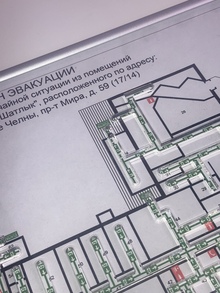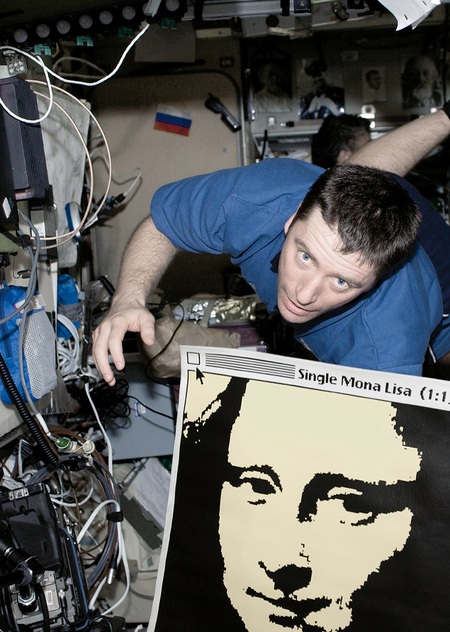
Mona Lisa Travels. VIII. Cosmic procession: Mona Lisa goes space
ULRICH HEIMANN
COSMIC PROCESSION: MONA LISA GOES SPACE
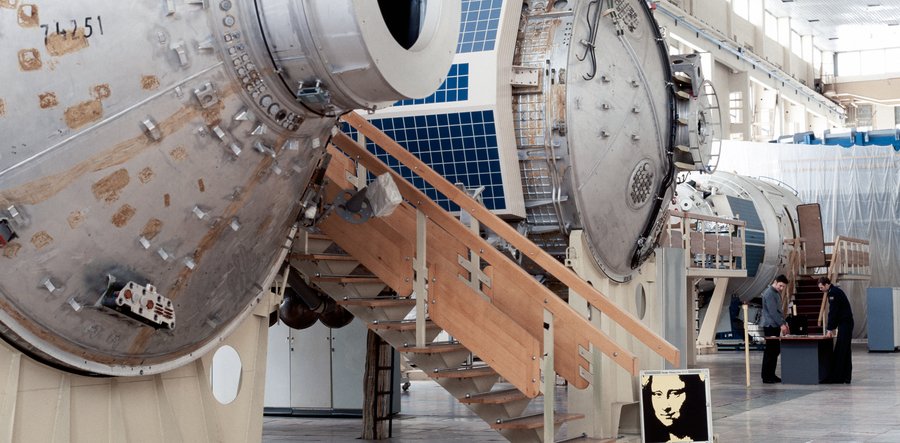
From the series Mona Lisa Goes Space. Cosmonaut Training Center.
MIR model, 2005. L-Print, 120×50 cm
On April 15, 2005, the spaceship Soyus TMA-6 started from the Baikonur Cosmodrome in Kazakhstan on an expedition to the International Space Station ISS. Among the crew were Sergei Krikalev (Roskosmos, Russia), Roberto Vittori (European Space Agency, Italy) and John Phillips (NASA, U.S.A.).
Along with freight for the space station and equipment for scientific experiments, Soyus catapulted something highly unusual into the cosmos: an artwork measuring 70×70 cm — George Pusenkoff’s Single Mona Lisa 1:1, painted in 1996 with acrylic on canvas.
The Italian astronaut Roberto Vittori looked after the picture during the mission. Another crewmember, Sergei Krikalev, brought to the ISS a transparent crystal in which a cilicon chip measuring 3×5 micrometers is enclosed. Here can be found another representation of the Single Mona Lisa 1:1 created by Pusenkoff, in this case painted, so to speak, with atoms in the nano dimensions. On April 25, 2005, the Single Mona Lisa 1:1 returned to Earth (folded twice, but otherwise in good condition).

Single Mona Lisa 1:1 at the International Space Station (ISS) with photos of Jury Gagarin and Konstantin Ziolkowski, April 2005
The project Mona Lisa Goes Space is the absolutely logical and yet, at the same time, remarkable, astonishing and admirable highpoint of the travelogue that George Pusenkoff has staged with the Single Mona Lisa 1:1 that he painted in 1996. The past and future travels of the picture — thus far, through Russia, Israel, Germany and Italy — have brought it to all sorts of locations where it has «posed» and been photographed by Pusenkoff. In this way, images have come about which can be described as a mixture of conceptual art and documentary photography.
The picture’s journeys recall memories of pictorial history and raise questions about the theory of signs. The first textual sources that report on traveling pictures make reference to the statues or painted pictures that represented Roman emperors and served their glorification. Replicas were produced from the painted or chiseled representations of these imperial images and transported to provincial cities as representatives of the absent imperial deities. The first sources dealing with the spread of Christian images and the worship of images date to the 4th century. The Mosaic prohibition of images, which Church Fathers had reinforced, lost its validity during the decline of the empire. The turning away from pictorial prohibition began after the Council of Nicaea in the year 325, which described Jesus Christ as the «identical son of God» and, furthermore, as his «completely identical image» — a definition that was called upon for the theological justification of the image.
Single Mona Lisa 1:1 at the ISS from 15.04 till 24.04.2005
Left: Russian space craft VOSTOK capsule, the Cosmonautic Museum, courtesy ESTEC. Center: Container («patches») for the painting Single Mona Lisa 1:1. Right: Marking labels for the patches
From the middle of the 6th century, sources testify to the existence of «acheiropoieta», allegedly images of Christ not created by human hand which, because they could work miracles, were carried by the emperors on military campaigns. Such beneficial acheiropoieta were, for example, the «Mandylion», a cloth with the impression of Jesus’ face, which Jesus Christ himself is alleged to have sent to King Abgar during a journey in Edessa, today part of Turkey, or portraits of the Virgin Mary with her child and the apostles, allegedly painted by Luke the evangelist. In the icon painting of the Eastern Church, such acheiropoieta were seen as possible models to be as meticulously imitated as possible. Thereby, it is not so much a question of resemblance in the mimetic sense, but far more one of an «essential similarity», of «communion». Interesting in this context are the legends of the miraculous self-multiplication of copies, which reaffirmed the essential similarity and miraculous activity of the replicas of an acheiropoietos.
Transparent prism with the Nano-Mona-Lisa in Weightlessness at the ISS, April 2005
Without a doubt, Pusenkoff’s Single Mona Lisa 1:1 and its journeys evoke the miraculous effect of acheiropoieta — or their essentially similar replicas — carried in processions or wartime campaigns.
But what sort of miracle will the Single Mona Lisa bring about, traveling the world and the cosmos? What is her «universal» mission?
The picture certainly can’t be thought of as a symbolic sign for Leonardo’s Gioconda. How should a conventionalized pictorial language signify a mode of representation so little standardized, so committed to individual distinctiveness, as that which Leonardo exercised in his portrait of Mona Lisa? Pusenkoff’s Single Mona Lisa is also not an iconic symbol of Leonardo’s picture (as would be the case with an exact copy or a poster with a reproduction of the painting, which one can buy in a museum shop).
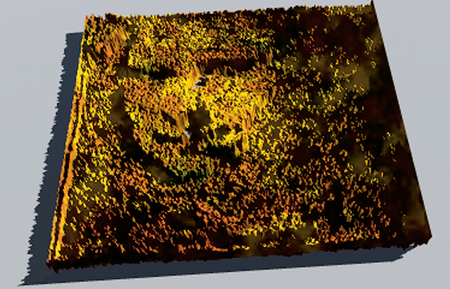
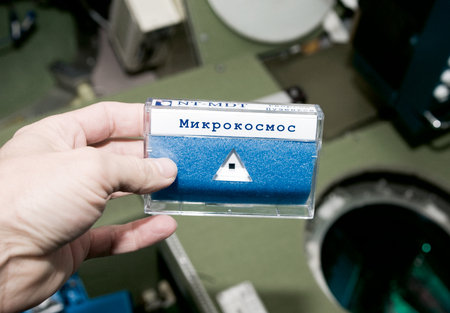
Left: A 2 μk titanium plate, carrying the image of Nano-Mona-Lisa.
Right: Container for the transparent prism with the Nano-Mona-
Lisa image at the ISS, April 2005
For Pusenkoff’s picture is substantially different than that of Leonardo. Pusenkoff’s picture offers merely a detail from Leonardo’s work. It also represents the youthful rejuvenation of the latter. Instead of the primarily brown coloration, Pusenkoff uses yellow and therefore follows the «modern» colorist concept of tonal intensification developed in the early 20th century. (Some viewers are reminded of the golden ground of medieval devotional pictures.) In addition, Pusenkoff «rejuvenates» the Mona Lisa through the fading out of all details that point to the «discourse» of the 16th century. (This discourse referred primarily to the modeling of the face through light and shadow and the bravura imitation of nature, as in the hair or the robe of the Gioconda, but also referred to the «sfumato» of the landscape background). And not least of all, beyond the strongly simplified representation of the facial features through rigid tonal separation, Pusenkoff concentrates primarily on a fundamental allusion in contemporary pictorial usage: digitalization. This allusion consists in the emphasis on the pixel, which has made possible the Mona Lisa’s worldwide presence as a digital image.
The ostentatious presentation of the pixel is therefore a further, essential ingredient in the rejuvenation to which Pusenkoff has subjected Mona Lisa.
From the series Mona Lisa Goes Space: Control center for the world’s largest centrifuge, 2005. L-Print, 120×150 cm
The Single Mona Lisa 1:1 sets out on her travels, like the imperial countenances or their replicas, like the acheiropoieta or their alleged self-propagation or through the humble repetition of acquired copies, in order to make claim to homage in the context of a cult. Under the sign of Leonardo da Vinci’s Mona Lisa, Pusenkoff formulates a claim on the art of our time: it — art — should become a cult of selfmeasurement against this antecedent in order to create a true artistic contemporaneousness. For Leonardo’s Mona Lisa is the most popular product of an artist whose creative thinking and acting encompassed in exemplary fashion the worldly wisdom of his time, whether cosmography and geography, mathematics, geometry, anatomy, botany, zoology, physics, medicine, optics and more, and who with his brilliant gift evinced a masterly command of the methods of painting, drawing, sculpture and architecture, as well as engineering.
Cosmonautic Museum, 2005
When looking at the photographs George Pusenkoff made during preparations for the launch of Soyuz to the International Space Station, showing the Single Mona Lisa 1:1 in front of the rocket during its transport to the launching ramp, some viewers will be reminded of the fact that Leonardo da Vinci studied the flight of birds and worked on designs for a flying machine. We also see Pusenkoff’s picture in the room of the astronaut Roberto Vittori in the cosmonauts’ training center at Swjosdny Gorodok, north of Moscow. Here, with his help, the Single Mona Lisa was present for the astronauts’ underwater training, for example, and was able to catch a glimpse into the control room of the largest centrifuge in the world. Thanks to the photos, we can also be eyewitnesses, and all of this would certainly have interested Leonardo, as well.
Top left: Cosmonaut Sergei Krikalev in the Cosmonaut Training Center, 2005. Top right: Underwater Training. Control, 2005. Bottom left: Canteen, 2005. Bottom right: Hotel for Cosmonauts, 2005
Top left: Spacecraft «Vostok» Capsule in the Cosmonautic Museum, 2004. Top right: In the Centrifuge Control Center. Bottom left: Swjosdny Gorodok. Bottom right: Cosmonaut Training Center. 2005
During the mission the astronauts and scientists live according to a protocol in which every minute is planned. Correspondingly, George Pusenkoff wrote scenarios for the photos and videos that were part of the protocol plan. On the basis of the photos made according to this protocol, we can follow how the Single Mona Lisa 1:1, removed from its stretcher, was carried on board the ISS, unpacked, unrolled and attached to the wall with a kind of Velcro fastener.
There is indeed a kind of iconographic installation here — a wall with photos of Yuri Gagarin, the first human in outer space, and Konstantin Tsiolkovsky, a kind of prophet and pioneer of space travel and, as such, a great-grandson of Leonardo. Artists of the Renaissance had the ambition to enjoy the same standing as leading figures in the fields of science and philosophy. In Leonardo we have the rare example of a brilliant artist who at the same time ranks as one of the fathers of modern, exact natural sciences. Today it is nothing unusual for artists of a particular sort to look down at scientific ways of thinking and at scientists themselves or, indeed, to see them as enemies of art. They exist in the «sulking corner of progress», as Beat Wyss termed it in his essay The World as T-shirt. In contrast, he describes the artist as a «surgeon who finds a visual solution whether manual, technical or in mixed forms».
On the Cosmodrome Baikonur, 2005
The technical production of images and the flood of digital pictures are so overpowering, according to Wyss, that in no case should art be «entrusted to the dilettantish magic of a creative laying on of hands». Instead, the high technical and intellectual profile of the Renaissance must be returned again to the artist’s profession and training.
On the Cosmodrome Baikonur, 2005
If one regards the journeys of George Pusenkoff’s Single Mona Lisa 1:1 as a manifestation for a humanistic (with all caution and with full knowledge of the enigmatic connotations of the term) reorientation of art above and beyond market cynicism and involuntary dilettantism, the spectacular destination of the cosmos becomes clear and requires no long-winded legitimation: What goal could express the seriousness (of which everyone must be convinced who considers alone the unimaginable organizational and financial exertion required of the person who seeks to realize such an idea) and the universality of this undertaking more convincingly than the cosmos?
Baikonur. Single Mona Lisa 1:1, 2005 (courtesy ESA)
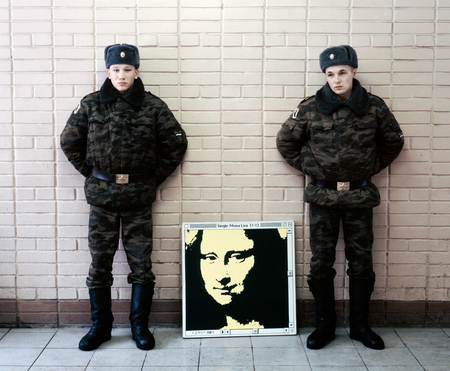
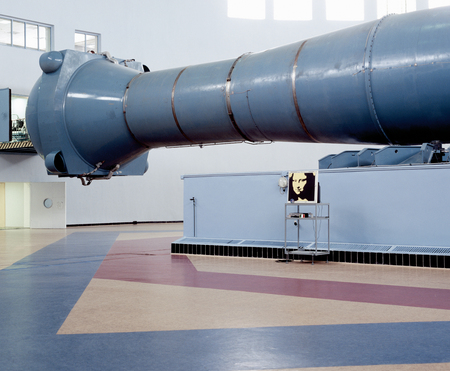
Swjosdny Gorodok. Left: Security, 2005. L-Print, 120×150 cm.
Right: Centrifuge, 2005. L-Print, 120×150 cm
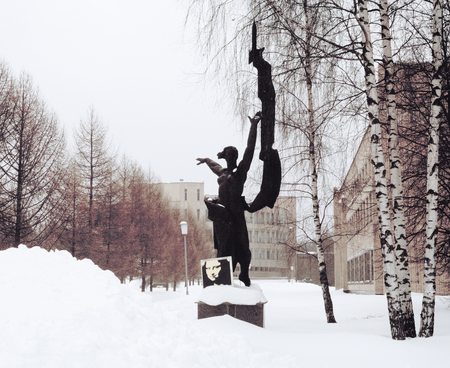

Swjosdny Gorodok. Left: Monument in the snow, 2005. L-Print, 120×150 cm. Right: Module of the space station «MIR», 2005.
L-Print, 120×150 cm
With the cosmonaut Sergei Krikalev during an eye test, 2004.
L-Print, 120×150 cm
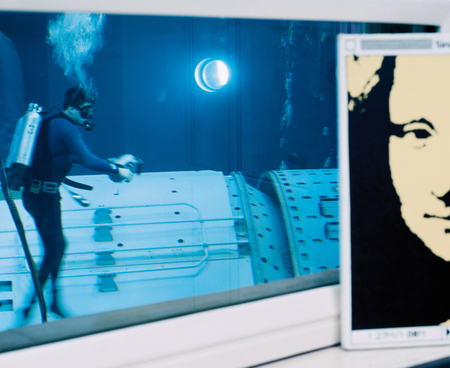

Swjosdny Gorodok. Left: Underwater Training, 2005. L-Print, 120×150 cm. Right: Centrifuge Capsule, 2005. L-Print, 120×150 cm
Swyosdny Gorodok. Checkpoint of the secret city, 2005 (courtesy FSA)

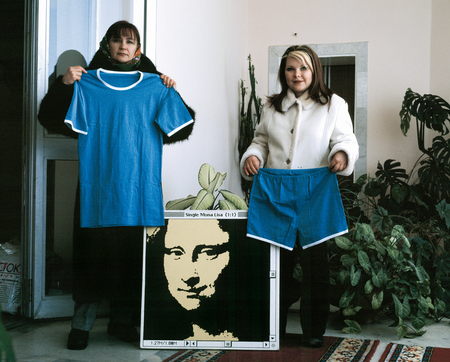
Left: Korolev. Women from the Rocet Factory, 2005. L-Print, 120×150 cm. Right: Swjosdny Gorodok. Fashion Design for Outer Space, 2005.
L-Print, 120×150 cm


Left: Korolev. With Roberto Vittori Preparing for Training, 2005. L-Print, 120×150 cm. Right: Swjosdny Gorodok. Spring in the Star City, 2004.
L-Print, 120×150 cm
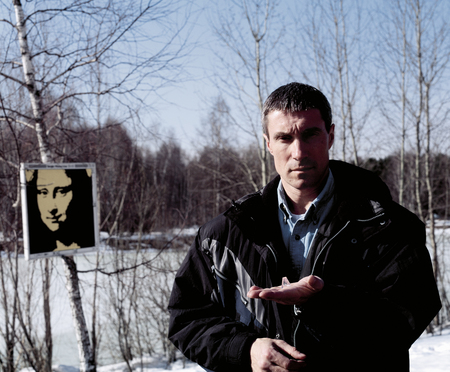
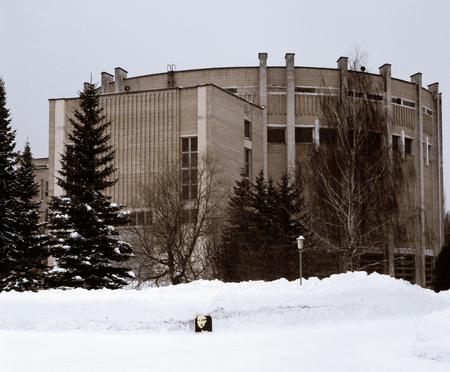
Swjosdny Gorodok. Left: Sergei Krikalev with Nano-Mona-Lisa, 2005. L-Print, 120×150 cm. Right: In front of the Centrifuge Hall, 2005. L-Print, 120×150 cm
International Space Station (ISS). Roberto Vittori with Single Mona Lisa 1:1 in the Weightlessness, April, 2005 (courtesy ESA)

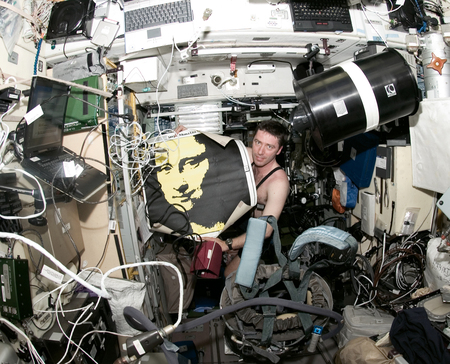
International Space Station (ISS), April 2005 (courtesy ESA).
Left: With Sergei Krikalev in the Weightlessness. Right: With Roberto Vittori in the Weightlessness
International Space Station (ISS). Single Mona Lisa 1:1.
The back of the painting, April 2005 (courtesy ESA)
